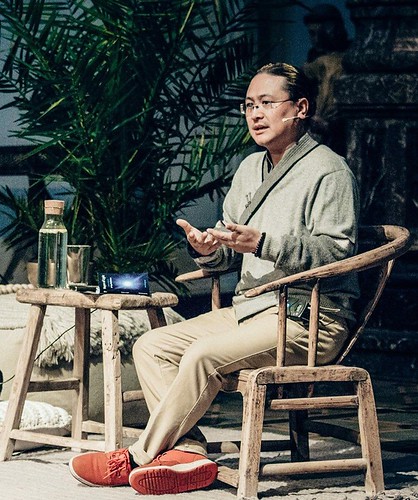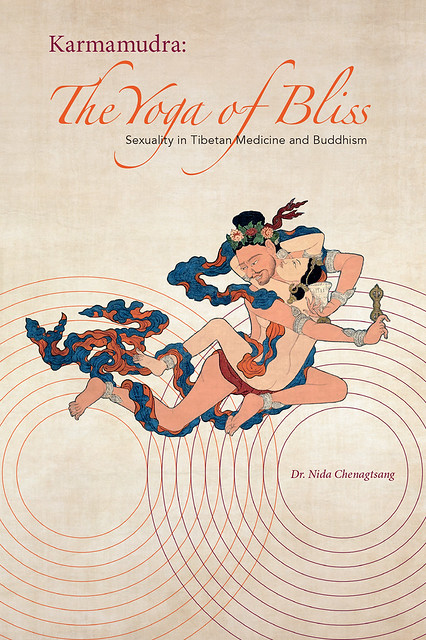FEATURES|THEMES|Health and Well-being
Demystifying the Yoga of Bliss: An Interview with Dr. Nida Chenagtsang, Part One
The Yoga of Bliss refers to the ancient Buddhist practice of sexual yoga, known as Karmamudra (Tib. lekyi chagya), which uses specific techniques to transform ordinary pleasure into a path of liberation from suffering in our cyclic existence. As a tantric technique, the practice has been an essential part of the Tibetan religious tradition since the arrival of Buddhism in Tibet. This intriguing theme is the subject of Dr. Nida Chenagtsang’s new book Karmamudra: The Yoga of Bliss (Sexuality in Tibetan Medicine and Buddhism).
Born in the traditional region of Amdo, Tibet, Dr. Nida is the co-founder and medical director of Sorig Khang International: Foundation for Traditional Tibetan Medicine. He is a Tibetan doctor, a yoga and meditation teacher, and the author of numerous books that have been translated into various languages. His most recent book was released by Sky Press, a publishing house dedicated to the promotion of the traditional art of Tibetan medicine. It debuted during the 6th annual Tibetan Traditional Medicine Sorig Congress held on 20–22 April in Pisa, Italy, and was launched worldwide on 25 April.
With this remarkable book, Dr. Nida aims to clarify some misconceptions related to the practice of Tibetan Buddhist sexual yoga and to explore both bio-medical and traditional Tibetan ideas about sexual health and well-being.
Buddhistdoor Global had the privilege of interviewing Dr. Nida after the release of his new book.
Buddhistdoor Global: What inspired you to write Karmamudra: The Yoga of Bliss?
Dr. Nida Chenagtsang: When I studied Vajrayana Buddhism, I always had questions about this topic. As a young person, I felt it was a very important practice but I did not have access to these teachings, so I was very curious. Later, when I did receive these teachings, I discovered that there was so much confusion and so many misunderstandings surrounding the topic, so I decided that it was very important to spread the proper information. At first, I wrote some explanations in Tibetan, in verse form, for Tibetan communities—I included parts in the book. Later, I saw that there was also a lot of confusion among Western Vajrayana Buddhist practitioners, perhaps even more so than in the East, so I decided to write about Karmamudra in English, as well. My main motivation for writing this book was to clarify confusion and the first chapter directly addresses all of the common misconceptions.
BDG: What are the qualities required for the practice of Karmamudra?
DNC: For every advanced practice, preparation is required. For Ati Yoga (Dzogchen), there are preliminary topics, and likewise for Mahamudra. Even to understand shunyata (emptiness) according to Sutrayana, there are many qualities that are required. For most Karmamudra practices you need to have a strong base in Tsa Lung (channels and winds) yoga exercises, and before doing Tsa Lung, there are other preliminary practices. Yuthok Yonten Gonpo, the founder of traditional Tibetan medicine, taught different methods of Karmamudra—one system was for those who are trained in Tsa Lung yogas, while another was for those not trained in these yogas. This is very unique because in most traditions it is only by mastering advanced Tsa Lung practices that one is able to engage in Karmamudra practice.
Today many masters are saying that no one is highly qualified in Tsa Lung, so therefore no one is qualified to practice Karmamudra. Yuthok disagreed with this point and taught Karmamudra in two different systems. The method for non-Tsa Lung practitioners is the subject of my book. Yuthok, of course, was not saying that we do not need any kind of qualities or preliminary training. For the second system, The pre-requisites are Ngöndro preliminary practices, Guru Yogas, and Kyerim (Creation Stage). The key point is that advanced yogic training with the channels and winds is not required. This is Yuthok’s very special way to present Karmamudra, which is practical and accessible to modern people.
BDG: Your book is dedicated to the victims of sexual abuse, especially those who have been abused in the name of spiritual and religious traditions. How can the Karmamudra teachings help those people and protect from such abuse?
DNC: The reason I dedicated this book to victims of sexual abuse is because I have many patients and friends who are victims, and I have seen the trauma and the pain that it has brought to people’s lives. Unfortunately, some of these cases have been within the Tibetan Vajrayana Buddhist tradition, and when people seek the cause of this abuse, they often come to the conclusion that the problem lies within the tradition itself. I want to clarify that the problem lies not in the system or the Karmamudra practice, the problem lies in the misuse of the teachings by certain individuals. The system itself has been abused by many teachers and this has caused great confusion amongst the students. Because I love this tradition, I wanted to share clear information about the practice so that the students can recognize when the tradition is being misused.
Of course, it is difficult to fix what has already been done, but proper education is the best method to prevent further abuses from taking place. These teachings have traditionally been kept secret to prevent potential misunderstandings or their misuse by unqualified people. But today, I think this secrecy has actually contributed to the misuse and abuse. If the students don’t have clear information, they may not be able to discern for themselves when they are being taken advantage of. I really hope that many young people will read this book and learn about authentic Karmamudra.
See more
Sorig Khang International
Sky Press
Related features from Buddhistdoor Global
The Growth of Wisdom and Compassion: An Interview with Drukmo Gyal Dakini, Part One
Connecting Modern Understanding to Ancient Wisdom: An Interview with Drukmo Gyal Dakini, Part Two
Exploring the Healing Practices of Tibetan Buddhism: Interview with Tulku Lobsang

















